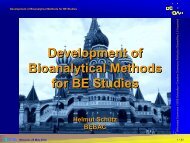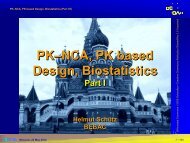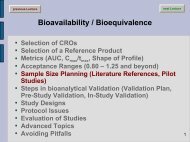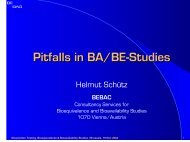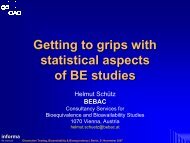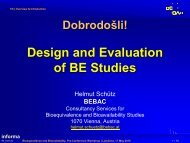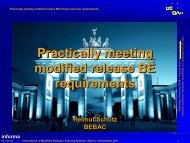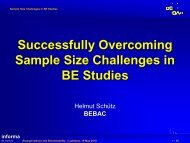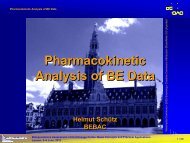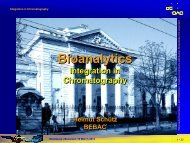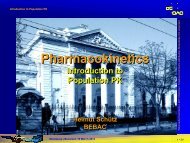Reference-Scaled Average Bioequivalence - BEBAC ⢠Consultancy ...
Reference-Scaled Average Bioequivalence - BEBAC ⢠Consultancy ...
Reference-Scaled Average Bioequivalence - BEBAC ⢠Consultancy ...
Create successful ePaper yourself
Turn your PDF publications into a flip-book with our unique Google optimized e-Paper software.
<strong>Reference</strong>-<strong>Scaled</strong> <strong>Average</strong> <strong>Bioequivalence</strong> (HVDs/HVDPs)<br />
π<br />
εχε<br />
π Pharma Edge<br />
Namaste!<br />
Biostatistics<br />
<strong>Reference</strong>-<strong>Scaled</strong><br />
<strong>Average</strong> <strong>Bioequivalence</strong><br />
(Part I: HVDs/HVDPs)<br />
Helmut Schütz<br />
<strong>BEBAC</strong><br />
Advanced concepts of IVIVC through case studies & Biostatistical aspects of <strong>Reference</strong>d scaled &<br />
Two Stage Designs: A regulatory perspective | Mumbai, 25 – 27 January 2013<br />
Wikimedia Commons • 2007 Sujit Kumar • Creative Commons Attribution-ShareAlike<br />
3.0 Unported<br />
1 • 46
<strong>Reference</strong>-<strong>Scaled</strong> <strong>Average</strong> <strong>Bioequivalence</strong> (HVDs/HVDPs)<br />
To bear in Remembrance...<br />
Whenever a theory appears to you<br />
as the only possible one, take this as<br />
a sign that you have neither under-<br />
stood the theory nor the problem<br />
which it was intended to solve.<br />
Even though it’s applied science<br />
we’re dealin’ with, it still is – science!<br />
Karl R. Popper<br />
π<br />
εχε<br />
π Pharma Edge<br />
Advanced concepts of IVIVC through case studies & Biostatistical aspects of <strong>Reference</strong>d scaled &<br />
Two Stage Designs: A regulatory perspective | Mumbai, 25 – 27 January 2013<br />
Leslie Z. Benet<br />
2 • 46
<strong>Reference</strong>-<strong>Scaled</strong> <strong>Average</strong> <strong>Bioequivalence</strong> (HVDs/HVDPs)<br />
High variability Modified from Fig. 1<br />
CI of ∆<br />
∆<br />
CI of ∆<br />
∆<br />
Tothfálusi et al. (2009)<br />
LL UL LL<br />
UL<br />
Counterintuitive<br />
concept of BE:<br />
π<br />
εχε<br />
π Pharma Edge<br />
Advanced concepts of IVIVC through case studies & Biostatistical aspects of <strong>Reference</strong>d scaled &<br />
Two Stage Designs: A regulatory perspective | Mumbai, 25 – 27 January 2013<br />
Two formulations with<br />
a large difference in<br />
means are declared<br />
bioequivalent if variances<br />
are low, but not<br />
bioequivalent – even<br />
if the difference is<br />
quite small – due to<br />
high variability.<br />
3 • 46
<strong>Reference</strong>-<strong>Scaled</strong> <strong>Average</strong> <strong>Bioequivalence</strong> (HVDs/HVDPs)<br />
High variability<br />
π<br />
εχε<br />
π Pharma Edge<br />
Power to show BE<br />
with 40 subjects for<br />
CV intra 30–50%<br />
µ T /µ R 0.95, CV intra 30%<br />
→ power 0.816<br />
µ T /µ R 1.00, CV intra 45%<br />
→ power 0.476 <<br />
Roulette 0.486 (!)<br />
µ T /µ R 0.95, CV intra 50%<br />
→ n=98 (power 0.803)<br />
Advanced concepts of IVIVC through case studies & Biostatistical aspects of <strong>Reference</strong>d scaled &<br />
Two Stage Designs: A regulatory perspective | Mumbai, 25 – 27 January 2013<br />
Power<br />
1<br />
0.9<br />
0.8<br />
0.7<br />
0.6<br />
0.5<br />
0.4<br />
0.3<br />
0.2<br />
0.1<br />
0<br />
2×2 Cross-over<br />
30 % CV<br />
35 % CV<br />
40 % CV<br />
45 % CV<br />
50 % CV<br />
n=40<br />
0.8 0.85 0.9 0.95 1 1.05 1.1 1.15 1.2 1.25<br />
µT/µR<br />
4 • 46
<strong>Reference</strong>-<strong>Scaled</strong> <strong>Average</strong> <strong>Bioequivalence</strong> (HVDs/HVDPs)<br />
HVDs/HVDPs are safe<br />
steep/flat PK/PD-curves<br />
resp. × 2<br />
response × 20<br />
π<br />
εχε<br />
π Pharma Edge<br />
10 100<br />
concentr. × 2<br />
Advanced concepts of IVIVC through case studies & Biostatistical aspects of <strong>Reference</strong>d scaled &<br />
Two Stage Designs: A regulatory perspective | Mumbai, 25 – 27 January 2013<br />
5 • 46
<strong>Reference</strong>-<strong>Scaled</strong> <strong>Average</strong> <strong>Bioequivalence</strong> (HVDs/HVDPs)<br />
HVDPs (FDA)<br />
All (!) ANDAs submitted to FDA/OGD<br />
2003 – 2005 (1010 studies, 180 drugs)<br />
31% (57/180) highly variable (CV ≥30%).<br />
of these HVDs/HVDPs,<br />
60% due to PK (e.g., first pass metabolism),<br />
20% formulation performance,<br />
20% unclear.<br />
π<br />
εχε<br />
π Pharma Edge<br />
Davit BM, Conner DP, Fabian-Fritsch B, Haidar SH, Jiang X, Patel DT, Seo PR,<br />
Suh K, Thompson CL, and LX Yu<br />
Highly Variable Drugs: Observations from <strong>Bioequivalence</strong> Data Submitted to the FDA for New Generic<br />
Drug Applications<br />
The AAPS Journal 10/1, 148–56 (2008)<br />
http://www.springerlink.com/content/51162107w327883r/fulltext.pdf<br />
Advanced concepts of IVIVC through case studies & Biostatistical aspects of <strong>Reference</strong>d scaled &<br />
Two Stage Designs: A regulatory perspective | Mumbai, 25 – 27 January 2013<br />
6 • 46
<strong>Reference</strong>-<strong>Scaled</strong> <strong>Average</strong> <strong>Bioequivalence</strong> (HVDs/HVDPs)<br />
HVDPs (FDA)<br />
Advisory Committee for Pharmaceutical<br />
Sciences (ACPS) to FDA (10/2006) on HVDs<br />
Follow-up papers in 2008 (ref. in API-GLs)<br />
Replicate study design [TRR|RTR|RRT].<br />
<strong>Reference</strong> <strong>Scaled</strong> <strong>Average</strong> <strong>Bioequivalence</strong> (RSABE).<br />
Minimum sample size 24 subjects.<br />
GMR restricted to [0.80,1.25].<br />
π<br />
εχε<br />
π Pharma Edge<br />
Haidar SH, Davit B, Chen M-L, Conner D, Lee LM, Li QH, Lionberger R, Makhlouf F, Patel D,<br />
Schuirmann DJ, and LX Yu<br />
<strong>Bioequivalence</strong> Approaches for Highly Variable Drugs and Drug Products<br />
Pharmaceutical Research 25/1, 237–41 (2008)<br />
http://www.springerlink.com/content/u503p62056413677/fulltext.pdf<br />
Haidar SH, Makhlouf F, Schuirmann DJ, Hyslop T, Davit B, Conner D, and LX Yu<br />
Evaluation of a Scaling Approach for the <strong>Bioequivalence</strong> of Highly Variable Drugs<br />
The AAPS Journal, 10/3, (2008) DOI: 10.1208/s12248-008-9053-4<br />
Advanced concepts of IVIVC through case studies & Biostatistical aspects of <strong>Reference</strong>d scaled &<br />
Two Stage Designs: A regulatory perspective | Mumbai, 25 – 27 January 2013<br />
7 • 46
<strong>Reference</strong>-<strong>Scaled</strong> <strong>Average</strong> <strong>Bioequivalence</strong> (HVDs/HVDPs)<br />
High variability<br />
π<br />
εχε<br />
π Pharma Edge<br />
For Highly Variable Drugs / Drug Products<br />
(HVDs/HVDPs) it may be almost impossible<br />
to show BE with a reasonable sample size.<br />
The common 2×2 cross-over design over<br />
assumes Independent Identically Distributions<br />
(IID), which may not hold. If e.g., the variability<br />
of the reference is higher than the one of the<br />
test, one obtains a high common (pooled)<br />
variance and the test will be penalized for the<br />
‘bad’ reference.<br />
Advanced concepts of IVIVC through case studies & Biostatistical aspects of <strong>Reference</strong>d scaled &<br />
Two Stage Designs: A regulatory perspective | Mumbai, 25 – 27 January 2013<br />
8 • 46
<strong>Reference</strong>-<strong>Scaled</strong> <strong>Average</strong> <strong>Bioequivalence</strong> (HVDs/HVDPs)<br />
Hierarchy of Designs<br />
Information<br />
π<br />
εχε<br />
π Pharma Edge<br />
The more ‘sophisticated’ a design is, the more<br />
information can be extracted<br />
Hierarchy of designs:<br />
Full replicate (TRTR | RTRT or TRT | RTR), <br />
Partial replicate (TRR | RTR | RRT) <br />
Standard 2×2 cross-over (RT | RT) <br />
Parallel (R | T)<br />
Variances which can be estimated:<br />
Parallel: total variance (between + within)<br />
2×2 Xover: + between, within subjects <br />
Partial replicate: + within subjects (reference) <br />
Full replicate: + within subjects (reference, test) <br />
Advanced concepts of IVIVC through case studies & Biostatistical aspects of <strong>Reference</strong>d scaled &<br />
Two Stage Designs: A regulatory perspective | Mumbai, 25 – 27 January 2013<br />
9 • 46
<strong>Reference</strong>-<strong>Scaled</strong> <strong>Average</strong> <strong>Bioequivalence</strong> (HVDs/HVDPs)<br />
Replicate designs<br />
Each subject is randomly assigned to<br />
sequences, where at least one of the treatments<br />
is administered at least twice<br />
Not only the global within-subject variability, but<br />
also the within-subject variability per treatment may<br />
be estimated.<br />
Smaller subject numbers compared to a standard<br />
2×2×2 design – but outweighed by an increased<br />
number of periods. Note: Same overall number of<br />
individual treatments!<br />
π<br />
εχε<br />
π Pharma Edge<br />
Advanced concepts of IVIVC through case studies & Biostatistical aspects of <strong>Reference</strong>d scaled &<br />
Two Stage Designs: A regulatory perspective | Mumbai, 25 – 27 January 2013<br />
10 • 46
<strong>Reference</strong>-<strong>Scaled</strong> <strong>Average</strong> <strong>Bioequivalence</strong> (HVDs/HVDPs)<br />
Replicate designs<br />
π<br />
εχε<br />
π Pharma Edge<br />
Any replicate design can be evaluated according to<br />
‘classical’ (unscaled) <strong>Average</strong> <strong>Bioequivalence</strong><br />
(ABE)<br />
ABE mandatory if scaling not allowed<br />
FDA: s WR<br />
<strong>Reference</strong>-<strong>Scaled</strong> <strong>Average</strong> <strong>Bioequivalence</strong> (HVDs/HVDPs)<br />
Application: HVDs/HVDPs<br />
HVDPs<br />
π<br />
εχε<br />
π Pharma Edge<br />
CV WR >30 %<br />
USA Recommended in API specific guidances.<br />
Scaling for AUC and/or C max acceptable,<br />
GMR 0.80 – 1.25; ≥24 subjects.<br />
± EU Widening of acceptance range (only C max ) to<br />
maximum of 69.84% – 143.19%),<br />
GMR 0.80 – 1.25.<br />
Demonstration that CV WR >30% is not caused<br />
by outliers.<br />
Justification that the widened acceptance<br />
range is clinically irrelevant.<br />
Advanced concepts of IVIVC through case studies & Biostatistical aspects of <strong>Reference</strong>d scaled &<br />
Two Stage Designs: A regulatory perspective | Mumbai, 25 – 27 January 2013<br />
12 • 46
<strong>Reference</strong>-<strong>Scaled</strong> <strong>Average</strong> <strong>Bioequivalence</strong> (HVDs/HVDPs)<br />
Replicate designs<br />
π<br />
εχε<br />
π Pharma Edge<br />
Two-sequence three-period<br />
T R T<br />
R T R<br />
Two-sequence four-period<br />
T R T R<br />
R T R T<br />
and many others…<br />
(FDA: TRR | RTR | RRT, aka ‘partial replicate’)<br />
The statistical model is complicated and<br />
depends on the actual design!<br />
X = µ ⋅π<br />
⋅Φ ⋅ s ⋅ e<br />
ijkl k l ij ijkl<br />
Advanced concepts of IVIVC through case studies & Biostatistical aspects of <strong>Reference</strong>d scaled &<br />
Two Stage Designs: A regulatory perspective | Mumbai, 25 – 27 January 2013<br />
13 • 46
<strong>Reference</strong>-<strong>Scaled</strong> <strong>Average</strong> <strong>Bioequivalence</strong> (HVDs/HVDPs)<br />
HVDPs (EMA vs. FDA)<br />
π<br />
εχε<br />
π Pharma Edge<br />
Tothfálusi et al. (2009), Fig. 3<br />
Simulated (n = 10 000) three-period full replicate design studies (TRT | RTR) in 36 subjects;<br />
GMR restriction 0.80–1.25. (a) CV = 35%, (b) CV = 45%, (c) CV = 55%.<br />
ABE: Conventional <strong>Average</strong> <strong>Bioequivalence</strong>, SABE: <strong>Scaled</strong> <strong>Average</strong> <strong>Bioequivalence</strong>,<br />
0.76: EMA criterion, 0.89: FDA criterion.<br />
Advanced concepts of IVIVC through case studies & Biostatistical aspects of <strong>Reference</strong>d scaled &<br />
Two Stage Designs: A regulatory perspective | Mumbai, 25 – 27 January 2013<br />
14 • 46
<strong>Reference</strong>-<strong>Scaled</strong> <strong>Average</strong> <strong>Bioequivalence</strong> (HVDs/HVDPs)<br />
HVDPs (EMA vs. FDA)<br />
EMA’s and FDA’s approaches differ; FDA’s leads<br />
to a discontinuity of the acceptance range at<br />
CV 30%, because FDA’s scaling CV is 25.83%<br />
(σ WR 0.294) – but applied at CV ≥30%.<br />
175%<br />
EMA (AUC)<br />
EMA (Cmax)<br />
FDA (AUC, Cmax)<br />
175%<br />
+0.50<br />
EMA (AUC)<br />
EMA (Cmax)<br />
FDA (AUC, Cmax)<br />
+0.50<br />
<strong>Bioequivalence</strong> limits<br />
150%<br />
125%<br />
100%<br />
75%<br />
150%<br />
125%<br />
100%<br />
75%<br />
ln <strong>Bioequivalence</strong> limits<br />
+0.25<br />
±0.00<br />
-0.25<br />
+0.25<br />
±0.00<br />
-0.25<br />
π<br />
εχε<br />
π Pharma Edge<br />
50%<br />
25% 35% 45% 55%<br />
CV intra(WR)<br />
Advanced concepts of IVIVC through case studies & Biostatistical aspects of <strong>Reference</strong>d scaled &<br />
Two Stage Designs: A regulatory perspective | Mumbai, 25 – 27 January 2013<br />
50%<br />
-0.50<br />
25% 35% 45% 55%<br />
CV intra(WR)<br />
-0.50<br />
15 • 46
<strong>Reference</strong>-<strong>Scaled</strong> <strong>Average</strong> <strong>Bioequivalence</strong> (HVDs/HVDPs)<br />
HVDPs (No Global Harmonization!)<br />
+0.50<br />
EMEA 2001, RUS 2008 (C max )<br />
+0.50<br />
ln <strong>Bioequivalence</strong> limits<br />
+0.25<br />
0.00<br />
-0.25<br />
-0.50<br />
25% 35% 45% 55%<br />
CV intra(WR)<br />
+0.25<br />
±0.00<br />
-0.25<br />
-0.50<br />
ln <strong>Bioequivalence</strong> limits<br />
+0.50<br />
+0.25<br />
0.00<br />
-0.25<br />
FDA (AUC, C max )<br />
-0.50<br />
25% 35% 45%<br />
CV intra(WR)<br />
55%<br />
+0.50<br />
+0.25<br />
±0.00<br />
-0.25<br />
-0.50<br />
ln <strong>Bioequivalence</strong> limits<br />
+0.50<br />
+0.25<br />
0.00<br />
-0.25<br />
EMA 2010 (C max )<br />
+0.50<br />
+0.25<br />
±0.00<br />
-0.25<br />
π<br />
εχε<br />
π Pharma Edge<br />
Advanced concepts of IVIVC through case studies & Biostatistical aspects of <strong>Reference</strong>d scaled &<br />
Two Stage Designs: A regulatory perspective | Mumbai, 25 – 27 January 2013<br />
-0.50<br />
25% 35% 45%<br />
CV intra(WR)<br />
55%<br />
-0.50<br />
16 • 46
<strong>Reference</strong>-<strong>Scaled</strong> <strong>Average</strong> <strong>Bioequivalence</strong> (HVDs/HVDPs)<br />
Replicate designs<br />
π<br />
εχε<br />
π Pharma Edge<br />
Sample size and other issues<br />
4-period replicate designs:<br />
sample size = ~½ of 2×2 study’s sample size.<br />
3-period replicate designs:<br />
sample size = ~¾ of 2×2 study’s sample size.<br />
Number of treatments (and biosamples)<br />
~conventional 2×2 cross-over.<br />
Allow for a safety margin – expect a higher number<br />
of drop-outs due to additional period(s).<br />
Consider increased blood loss (ethics!); eventually<br />
improved bioanalytics required.<br />
Advanced concepts of IVIVC through case studies & Biostatistical aspects of <strong>Reference</strong>d scaled &<br />
Two Stage Designs: A regulatory perspective | Mumbai, 25 – 27 January 2013<br />
17 • 46
<strong>Reference</strong>-<strong>Scaled</strong> <strong>Average</strong> <strong>Bioequivalence</strong> (HVDs/HVDPs)<br />
HVDPs (EMA vs. FDA)<br />
At higher CVs the GMR is of increasing importance!<br />
EMA: CV WR >50% still requires large sample sizes.<br />
No algorithm for sample size estimation (based on<br />
α, β, GMR, and CV ) can deal with the GMR<br />
restriction.<br />
Recently sample size tables based on simulations<br />
were published (for EMA’s and FDA’s methods,<br />
full and partial replicate designs, CV WR 30–80%,<br />
power 80 and 90%).<br />
π<br />
εχε<br />
π Pharma Edge<br />
L Tothfálusi and L Endrényi<br />
Sample Sizes for Designing <strong>Bioequivalence</strong> Studies for Highly Variable Drugs<br />
J Pharm Pharmaceut Sci 15(1), 73–84 (2011)<br />
http://ejournals.library.ualberta.ca/index.php/JPPS/article/download/11612/9489<br />
Advanced concepts of IVIVC through case studies & Biostatistical aspects of <strong>Reference</strong>d scaled &<br />
Two Stage Designs: A regulatory perspective | Mumbai, 25 – 27 January 2013<br />
18 • 46
20<br />
35<br />
<strong>Reference</strong>-<strong>Scaled</strong> <strong>Average</strong> <strong>Bioequivalence</strong> (HVDs/HVDPs)<br />
HVDPs (EMA/FDA; sample sizes)<br />
CV%<br />
80<br />
70<br />
60<br />
50<br />
40<br />
75 80<br />
65<br />
60<br />
50<br />
35<br />
30<br />
0.85 0.90 0.95 1.00 1.05 1.10 1.15 1.20<br />
π<br />
εχε<br />
π Pharma Edge<br />
55<br />
RTRT|TRTR, 80% power, EMA-method<br />
45<br />
30<br />
40<br />
25<br />
20<br />
GMR<br />
40<br />
65<br />
60<br />
45<br />
50<br />
55<br />
130<br />
80<br />
105<br />
100<br />
sample<br />
size<br />
Advanced concepts of IVIVC through case studies & Biostatistical aspects of <strong>Reference</strong>d scaled &<br />
Two Stage Designs: A regulatory perspective | Mumbai, 25 – 27 January 2013<br />
200<br />
195<br />
190<br />
185<br />
180<br />
175<br />
170<br />
165<br />
160<br />
155<br />
150<br />
145<br />
140<br />
135<br />
130<br />
125<br />
120<br />
115<br />
110<br />
105<br />
100<br />
95<br />
90<br />
85<br />
80<br />
75<br />
70<br />
65<br />
60<br />
55<br />
50<br />
45<br />
40<br />
35<br />
30<br />
25<br />
20<br />
15<br />
CV%<br />
80<br />
70<br />
60<br />
50<br />
40<br />
45<br />
40<br />
35<br />
25<br />
30<br />
RTRT|TRTR, 80% power, FDA-method<br />
30<br />
0.85 0.90 0.95 1.00 1.05 1.10 1.15 1.20<br />
GMR<br />
25<br />
30<br />
45<br />
40<br />
55<br />
50<br />
60<br />
130<br />
100<br />
85<br />
sample<br />
size<br />
19 • 46<br />
200<br />
195<br />
190<br />
185<br />
180<br />
175<br />
170<br />
165<br />
160<br />
155<br />
150<br />
145<br />
140<br />
135<br />
130<br />
125<br />
120<br />
115<br />
110<br />
105<br />
100<br />
95<br />
90<br />
85<br />
80<br />
75<br />
70<br />
65<br />
60<br />
55<br />
50<br />
45<br />
40<br />
35<br />
30<br />
25<br />
20<br />
15
<strong>Reference</strong>-<strong>Scaled</strong> <strong>Average</strong> <strong>Bioequivalence</strong> (HVDs/HVDPs)<br />
HVDPs (Regulatory models)<br />
Common to EMA and FDA<br />
ABE model<br />
−θ ≤ µ − µ ≤ + θ<br />
A T R A<br />
SABE model<br />
µ<br />
T<br />
− µ<br />
R<br />
−θ<br />
S<br />
≤ ≤ + θS<br />
σ<br />
W<br />
Regulatory regulatory switching condition θ S is derived<br />
from the regulatory standardized variation σ 0 (proportionality<br />
between acceptance limits in ln-scale and<br />
σ W in the highly variable region).<br />
π<br />
εχε<br />
π Pharma Edge<br />
Tothfálusi et al. (2009)<br />
Advanced concepts of IVIVC through case studies & Biostatistical aspects of <strong>Reference</strong>d scaled &<br />
Two Stage Designs: A regulatory perspective | Mumbai, 25 – 27 January 2013<br />
20 • 46
<strong>Reference</strong>-<strong>Scaled</strong> <strong>Average</strong> <strong>Bioequivalence</strong> (HVDs/HVDPs)<br />
HVDPs (Regulary models)<br />
Differences between EMA and FDA<br />
FDA: Regulatory regulatory switching condition θ S is<br />
set to 0.893, which would translate into<br />
CV WR<br />
⎛ ln(1.25) ⎞<br />
⎜ ⎟<br />
⎝ 0.893 ⎠<br />
= 100 e −1 ≈ 25.83%<br />
2<br />
RSABE is allowed only if CV WR ≥ 30% (s WR ≥ 0.294),<br />
which explains to the discontinuity at 30%.<br />
π<br />
εχε<br />
π Pharma Edge<br />
Advanced concepts of IVIVC through case studies & Biostatistical aspects of <strong>Reference</strong>d scaled &<br />
Two Stage Designs: A regulatory perspective | Mumbai, 25 – 27 January 2013<br />
21 • 46
<strong>Reference</strong>-<strong>Scaled</strong> <strong>Average</strong> <strong>Bioequivalence</strong> (HVDs/HVDPs)<br />
HVDPs (Regulatory models)<br />
Differences between EMA and FDA<br />
EMA: Regulatory regulatory switching condition θ S<br />
avoids the discontinuity.<br />
CV<br />
σ<br />
0<br />
W<br />
=<br />
0.30<br />
= + =<br />
2<br />
ln( CVW<br />
1) 0.29356<br />
0 0<br />
03792085 …<br />
ln(1.25) ln(0.80)<br />
θS<br />
= = − ≈ 0.760<br />
σ σ<br />
π<br />
εχε<br />
π Pharma Edge<br />
Advanced concepts of IVIVC through case studies & Biostatistical aspects of <strong>Reference</strong>d scaled &<br />
Two Stage Designs: A regulatory perspective | Mumbai, 25 – 27 January 2013<br />
22 • 46
<strong>Reference</strong>-<strong>Scaled</strong> <strong>Average</strong> <strong>Bioequivalence</strong> (HVDs/HVDPs)<br />
HVDPs (FDA)<br />
π<br />
εχε<br />
π Pharma Edge<br />
Haidar et al. (2008), progesterone guid. (2010)<br />
Starting from the SABE model<br />
µ<br />
T<br />
− µ<br />
R<br />
−θ<br />
S<br />
≤ ≤ + θS<br />
σW<br />
Rearrangement leads to a linear form<br />
µ − µ −θ ⋅σ<br />
≤ 0<br />
( ) 2 2 2<br />
T R S W<br />
Since we don’t have the true parameters, we use<br />
estimates<br />
E = µ − µ<br />
E<br />
( ) 2<br />
m T R<br />
= θ ⋅σ<br />
2 2<br />
s S W<br />
Advanced concepts of IVIVC through case studies & Biostatistical aspects of <strong>Reference</strong>d scaled &<br />
Two Stage Designs: A regulatory perspective | Mumbai, 25 – 27 January 2013<br />
23 • 46
<strong>Reference</strong>-<strong>Scaled</strong> <strong>Average</strong> <strong>Bioequivalence</strong> (HVDs/HVDPs)<br />
HVDPs (FDA)<br />
π<br />
εχε<br />
π Pharma Edge<br />
Haidar et al. (2008), progesterone guid. (2010)<br />
Distributions of E m and E s are known and their upper<br />
confidence limits can be calculated<br />
( α , − )<br />
C = m − m + t ⋅ SE<br />
C<br />
m T R N S<br />
s<br />
( )<br />
θ ⋅ N − S ⋅ s<br />
=<br />
2 2<br />
S<br />
W<br />
2<br />
χα<br />
, N −S<br />
t and χ² are the inverse cumulative distribution<br />
functions at α 0.05 and N – S degrees of freedom<br />
(N subjects, S sequences). SE is the standard error of<br />
the difference between means.<br />
Advanced concepts of IVIVC through case studies & Biostatistical aspects of <strong>Reference</strong>d scaled &<br />
Two Stage Designs: A regulatory perspective | Mumbai, 25 – 27 January 2013<br />
2<br />
24 • 46
<strong>Reference</strong>-<strong>Scaled</strong> <strong>Average</strong> <strong>Bioequivalence</strong> (HVDs/HVDPs)<br />
HVDPs (FDA)<br />
Haidar et al. (2008), progesterone guid. (2010)<br />
Howe method gets the CL from individual CIs<br />
( )<br />
L = C − E<br />
m m m<br />
( )<br />
L = C − E<br />
s s s<br />
CL = E − E + L + L<br />
2<br />
2<br />
m s m s<br />
The CL of the rearranged SABE criterion is evaluated<br />
at the 95% level. If the upper 95% is positive, RSABE<br />
is rejected, and accepted otherwise.<br />
π<br />
εχε<br />
π Pharma Edge<br />
Advanced concepts of IVIVC through case studies & Biostatistical aspects of <strong>Reference</strong>d scaled &<br />
Two Stage Designs: A regulatory perspective | Mumbai, 25 – 27 January 2013<br />
25 • 46
<strong>Reference</strong>-<strong>Scaled</strong> <strong>Average</strong> <strong>Bioequivalence</strong> (HVDs/HVDPs)<br />
HVDPs (EMA)<br />
EU GL on BE (2010)<br />
<strong>Average</strong> <strong>Bioequivalence</strong> with Expanding Limits<br />
(ABEL)<br />
The regulatory switching condition θ S<br />
at CV WR<br />
30%<br />
would be 0.7601228297680…<br />
According to the GLs and the EMA’s Q&A document<br />
(2011, 2012) use k (≡θ S<br />
) with 0.760 (not the exact<br />
value).<br />
π<br />
εχε<br />
π Pharma Edge<br />
Advanced concepts of IVIVC through case studies & Biostatistical aspects of <strong>Reference</strong>d scaled &<br />
Two Stage Designs: A regulatory perspective | Mumbai, 25 – 27 January 2013<br />
26 • 46
<strong>Reference</strong>-<strong>Scaled</strong> <strong>Average</strong> <strong>Bioequivalence</strong> (HVDs/HVDPs)<br />
HVDPs (EMA)<br />
π<br />
εχε<br />
π Pharma Edge<br />
EU GL on BE (2010)<br />
<strong>Average</strong> <strong>Bioequivalence</strong> (ABE) with Expanding<br />
Limits (ABEL)<br />
Based on σ WR<br />
(the intra-subject standard deviation of<br />
the reference formulation) calculate the scaled<br />
acceptance range based on the regulatory constant k<br />
(θ s<br />
=0.760); limited at CV WR 50%.<br />
k WR<br />
[ L U ] e ⋅σ<br />
CV WR<br />
− = ∓ ≤30 80.00 – 125.00<br />
35 77.23 – 129.48<br />
40 74.62 – 143.02<br />
45 72.15 – 138.59<br />
≥50<br />
Advanced concepts of IVIVC through case studies & Biostatistical aspects of <strong>Reference</strong>d scaled &<br />
Two Stage Designs: A regulatory perspective | Mumbai, 25 – 27 January 2013<br />
L – U<br />
69.84 – 143.19<br />
27 • 46
<strong>Reference</strong>-<strong>Scaled</strong> <strong>Average</strong> <strong>Bioequivalence</strong> (HVDs/HVDPs)<br />
HVDPs (EMA)<br />
Q&A document (March 2011)<br />
Two methods proposed (Method A preferred)<br />
Method A: All effects fixed; assumes equal variances<br />
of test and reference, and no subject-by-formulation<br />
interaction; only a common within (intra-) subject<br />
variance is estimated.<br />
Method B: Similar to A, but random effects for<br />
subjects. Common within (intra-) subject variance<br />
and between (inter-) subject variance are estimated.<br />
Outliers: Boxplots (of model residuals?) suggested.<br />
π<br />
εχε<br />
π Pharma Edge<br />
Questions & Answers on the Revised EMA <strong>Bioequivalence</strong> Guideline<br />
Summary of the discussions held at the 3 rd EGA Symposium on <strong>Bioequivalence</strong><br />
June 2010, London<br />
http://www.egagenerics.com/doc/EGA_BEQ_Q&A_WEB_QA_1_32.pdf<br />
Advanced concepts of IVIVC through case studies & Biostatistical aspects of <strong>Reference</strong>d scaled &<br />
Two Stage Designs: A regulatory perspective | Mumbai, 25 – 27 January 2013<br />
28 • 46
<strong>Reference</strong>-<strong>Scaled</strong> <strong>Average</strong> <strong>Bioequivalence</strong> (HVDs/HVDPs)<br />
Example datasets (EMA)<br />
π<br />
εχε<br />
π Pharma Edge<br />
Q&A document (March 2011)<br />
Data set I<br />
RTRT | TRTR full replicate, 77 subjects, imbalanced,<br />
incomplete<br />
FDA<br />
s WR<br />
0.446 ≥0.294 → apply RSABE (CV WR<br />
46.96%)<br />
a. critbound –0.0921 ≤0 and<br />
b. PE 115.46% ⊂ 80.00–125.00%<br />
EMA<br />
CV WR 46.96% → apply ABEL (> 30%)<br />
<strong>Scaled</strong> Acceptance Range: 71.23–140.40%<br />
Method A: 90% CI 107.11–124.89% ⊂ AR; PE 115.66%<br />
Method B: 90% CI 107.17–124.97% ⊂ AR; PE 115.73%<br />
<br />
Advanced concepts of IVIVC through case studies & Biostatistical aspects of <strong>Reference</strong>d scaled &<br />
Two Stage Designs: A regulatory perspective | Mumbai, 25 – 27 January 2013<br />
<br />
29 • 46
<strong>Reference</strong>-<strong>Scaled</strong> <strong>Average</strong> <strong>Bioequivalence</strong> (HVDs/HVDPs)<br />
Example datasets (EMA)<br />
π<br />
εχε<br />
π Pharma Edge<br />
Q&A document (March 2011)<br />
Data set II<br />
TRR | RTR | RRT partial replicate, 24 subjects,<br />
balanced, complete<br />
FDA<br />
s WR<br />
0.114
<strong>Reference</strong>-<strong>Scaled</strong> <strong>Average</strong> <strong>Bioequivalence</strong> (HVDs/HVDPs)<br />
Outliers (EMA)<br />
π<br />
εχε<br />
π Pharma Edge<br />
EMA GL on BE (2010), Section 4.1.10<br />
The applicant should justify that the calculated<br />
intra-subject variability is a reliable estimate and<br />
that it is not the result of outliers.<br />
EGA/EMA Q&A (2010)<br />
Question:<br />
How should a company proceed if outlier values are<br />
observed for the reference product in a replicate<br />
design study for a Highly Variable Drug Product<br />
(HVDP)?<br />
Advanced concepts of IVIVC through case studies & Biostatistical aspects of <strong>Reference</strong>d scaled &<br />
Two Stage Designs: A regulatory perspective | Mumbai, 25 – 27 January 2013<br />
31 • 46
<strong>Reference</strong>-<strong>Scaled</strong> <strong>Average</strong> <strong>Bioequivalence</strong> (HVDs/HVDPs)<br />
Outliers (EMA)<br />
EGA/EMA Q&A (2010)<br />
Answer:<br />
The outlier cannot be removed from evaluation […]<br />
but should not be taken into account for calculation<br />
of within-subject variability and extension of the<br />
acceptance range.<br />
An outlier test is not an expectation of the<br />
medicines agencies but outliers could be shown by<br />
a box plot. This would allow the medicines agencies<br />
to compare the data between them.<br />
π<br />
εχε<br />
π Pharma Edge<br />
Advanced concepts of IVIVC through case studies & Biostatistical aspects of <strong>Reference</strong>d scaled &<br />
Two Stage Designs: A regulatory perspective | Mumbai, 25 – 27 January 2013<br />
32 • 46
<strong>Reference</strong>-<strong>Scaled</strong> <strong>Average</strong> <strong>Bioequivalence</strong> (HVDs/HVDPs)<br />
Outliers (EMA)<br />
π<br />
εχε<br />
π Pharma Edge<br />
Data set I (full replicate)<br />
CV WR 46.96%<br />
EL 71.23–140.40%<br />
Method A: 107.11–124.89%<br />
Method B: 107.17–124.97%<br />
But there are two outliers!<br />
By excluding subjects 45 and 52<br />
CV WR drops to 32.16%.<br />
EL 78.79–126.93%<br />
Almost no more gain compared<br />
to conventional limits.<br />
Advanced concepts of IVIVC through case studies & Biostatistical aspects of <strong>Reference</strong>d scaled &<br />
Two Stage Designs: A regulatory perspective | Mumbai, 25 – 27 January 2013<br />
Studentized Residual<br />
6<br />
4<br />
2<br />
0<br />
-2<br />
-4<br />
-6<br />
33 • 46
<strong>Reference</strong>-<strong>Scaled</strong> <strong>Average</strong> <strong>Bioequivalence</strong> (HVDs/HVDPs)<br />
Thank You!<br />
<strong>Reference</strong>-<strong>Scaled</strong><br />
<strong>Average</strong> <strong>Bioequivalence</strong> (Part I)<br />
Open Questions?<br />
Helmut Schütz<br />
<strong>BEBAC</strong><br />
<strong>Consultancy</strong> Services for<br />
<strong>Bioequivalence</strong> and Bioavailability Studies<br />
1070 Vienna, Austria<br />
helmut.schuetz@bebac.at<br />
π<br />
εχε<br />
π Pharma Edge<br />
Advanced concepts of IVIVC through case studies & Biostatistical aspects of <strong>Reference</strong>d scaled &<br />
Two Stage Designs: A regulatory perspective | Mumbai, 25 – 27 January 2013<br />
34 • 46
<strong>Reference</strong>-<strong>Scaled</strong> <strong>Average</strong> <strong>Bioequivalence</strong> (HVDs/HVDPs)<br />
To bear in Remembrance...<br />
The fundamental cause of trouble in the world today is<br />
that the stupid are cocksure<br />
while the intelligent are full of doubt.<br />
Bertrand Russell<br />
You should treat as many patients as possible with the<br />
new drugs while they still have the power to heal.<br />
Armand Trousseau<br />
π<br />
εχε<br />
π Pharma Edge<br />
If you shut your door to all errors truth will be shut out.<br />
Rabindranath Tagore<br />
Advanced concepts of IVIVC through case studies & Biostatistical aspects of <strong>Reference</strong>d scaled &<br />
Two Stage Designs: A regulatory perspective | Mumbai, 25 – 27 January 2013<br />
35 • 46
<strong>Reference</strong>-<strong>Scaled</strong> <strong>Average</strong> <strong>Bioequivalence</strong> (HVDs/HVDPs)<br />
<strong>Reference</strong>s<br />
ICH<br />
E9: Statistical Principles for Clinical Trials (1998)<br />
EMA-CPMP/CHMP/EWP<br />
Guideline on the Investigation of BE (2010)<br />
Questions & Answers: Positions on specific questions<br />
addressed to the EWP therapeutic subgroup on<br />
Pharmacokinetics (2011, 2012)<br />
US-FDA<br />
Center for Drug Evaluation and Research (CDER)<br />
Statistical Approaches Establishing<br />
<strong>Bioequivalence</strong> (2001)<br />
<strong>Bioequivalence</strong> Recommendations for Specific<br />
Products (2007–2012):<br />
Draft Guidance on Progesterone (Feb 2011)<br />
Karalis V, Macheras P, and M Symillides<br />
Geometric mean ratio-dependent scaled bioequivalence<br />
limits with leveling-off properties<br />
Eur J Pharm Sci 26/1, 54–61 (2005)<br />
DOI: 10.1016/j.ejps.2005.04.019<br />
Davit BM et al.<br />
Highly Variable Drugs: Observations from <strong>Bioequivalence</strong> Data<br />
Submitted to the FDA for New Generic Drug Applications<br />
The AAPS Journal 10/1, 148–56 (2008)<br />
DOI: 10.1208/s12248-008-9015-x<br />
Haidar SH et al.<br />
<strong>Bioequivalence</strong> Approaches for Highly Variable Drugs and<br />
Drug Products<br />
Pharm Res 25/1, 237–41 (2008)<br />
DOI: 10.1007/s11095-007-9434-x<br />
Haidar SH et al.<br />
Evaluation of a Scaling Approach for the <strong>Bioequivalence</strong> of<br />
Highly Variable Drugs<br />
The AAPS Journal, 10/3, 450–4 (2008)<br />
DOI: 10.1208/s12248-008-9053-4<br />
Endrényi L and L Tothfálusi<br />
Regulatory conditions for the determination of bioequivalence<br />
of highly variable drugs<br />
J Pharm Pharm Sci 12, 138–149 (2009)<br />
π<br />
εχε<br />
π Pharma Edge<br />
Advanced concepts of IVIVC through case studies & Biostatistical aspects of <strong>Reference</strong>d scaled &<br />
Two Stage Designs: A regulatory perspective | Mumbai, 25 – 27 January 2013<br />
36 • 46
<strong>Reference</strong>-<strong>Scaled</strong> <strong>Average</strong> <strong>Bioequivalence</strong> (HVDs/HVDPs)<br />
<strong>Reference</strong>s<br />
Tothfálusi L, Endrényi L, and A García-Arieta<br />
Evaluation of <strong>Bioequivalence</strong> for Highly Variable Drugs<br />
with <strong>Scaled</strong> <strong>Average</strong> <strong>Bioequivalence</strong><br />
Clin Pharmacokinet 48/11, 725–43 (2009)<br />
DOI: 10.2165/11318040-000000000-00000<br />
Anon.<br />
Questions & Answers on the Revised EMA<br />
<strong>Bioequivalence</strong> Guideline: Summary of the discussions<br />
held at the 3 rd EGA Symposium on <strong>Bioequivalence</strong><br />
June 2010, London<br />
http://www.egagenerics.com/doc/EGA_BEQ_Q&A_WEB_<br />
QA_1_32.pdf<br />
Tothfálusi L and L Endrényi<br />
Sample Sizes for Designing <strong>Bioequivalence</strong> Studies for<br />
Highly Variable Drugs<br />
J Pharm Pharmaceut Sci 15(1), 73–84 (2011)<br />
Karalis V, Symillides M, and P Macheras<br />
On the leveling-off properties of the new bioequivalence<br />
limits for highly variable drugs of the EMA guideline<br />
Eur J Pharm Sci 44, 497–505 (2011)<br />
π<br />
εχε<br />
π Pharma Edge<br />
Karalis V, Symillides M, and P Macheras<br />
<strong>Bioequivalence</strong> of Highly Variable Drugs: A Comparison<br />
of the Newly Proposed Regulatory Approaches by FDA<br />
and EMA<br />
Pharm Res 29, 1066–77 (2012)<br />
DOI: 10.1007/s11095-011-0651-y<br />
Symillides M, Karalis V, and P Macheras<br />
Exploring the Relationships Between <strong>Scaled</strong><br />
<strong>Bioequivalence</strong> Limits and Within-Subject Variability<br />
J Pharm Sci (Epub ahead of print, 15 Nov 2012)<br />
DOI: 10.1002/jps.23365<br />
García-Arieta A and J Gordon<br />
<strong>Bioequivalence</strong> Requirements in the European Union:<br />
Critical Discussion<br />
The AAPS Journal 14/4, 738–48 (2012)<br />
DOI: 10.1208/s12248-012-9382-1<br />
Davit BM et al.<br />
Implementation of a <strong>Reference</strong>-<strong>Scaled</strong> <strong>Average</strong> <strong>Bioequivalence</strong><br />
Approach for Highly Variable Generic Drug<br />
Products by the US Food and Drug Administration<br />
The AAPS Journal 14/4, 915–24 (2012)<br />
DOI: 10.1208/s12248-012-9406-x<br />
Advanced concepts of IVIVC through case studies & Biostatistical aspects of <strong>Reference</strong>d scaled &<br />
Two Stage Designs: A regulatory perspective | Mumbai, 25 – 27 January 2013<br />
37 • 46
<strong>Reference</strong>-<strong>Scaled</strong> <strong>Average</strong> <strong>Bioequivalence</strong> (HVDs/HVDPs)<br />
Method A<br />
SAS code (EMA)<br />
proc glm data=replicate;<br />
class formulation subject period sequence;<br />
model logDATA= sequence subject(sequence) period formulation;<br />
estimate "test-ref" formulation -1+1;<br />
test h=sequence e=subject(sequence);<br />
lsmeans formulation / adjust=t pdiff=control("R") CL alpha=0.10<br />
0.10;<br />
run;<br />
Method B<br />
π<br />
εχε<br />
π Pharma Edge<br />
proc mixed data=replicate;<br />
class formulation subject period sequence;<br />
model logDATA= sequence period formulation;<br />
random subject(sequence);<br />
estimate "test-ref" formulation -1 1 1 / CL alpha=0.10<br />
0.10;<br />
run;<br />
CV WR (both methods)<br />
data var;<br />
set replicate;<br />
if formulation='R';<br />
run;<br />
proc glm data=var;<br />
class subject period sequence;<br />
model logDATA= sequence subject(sequence) period;<br />
run;<br />
Advanced concepts of IVIVC through case studies & Biostatistical aspects of <strong>Reference</strong>d scaled &<br />
Two Stage Designs: A regulatory perspective | Mumbai, 25 – 27 January 2013<br />
38 • 46
<strong>Reference</strong>-<strong>Scaled</strong> <strong>Average</strong> <strong>Bioequivalence</strong> (HVDs/HVDPs)<br />
Partial reference-replicated 3-way design<br />
data test;<br />
set pk;<br />
if trt='T';<br />
latt=lauct;<br />
run;<br />
SAS code (FDA)<br />
data ref1;<br />
set ref;<br />
if (seq=1 and per=2) or (seq=2 and per=1) or (seq=3 and per=1);<br />
lat1r=lauct;<br />
run;<br />
data ref2;<br />
set ref;<br />
if (seq=1 and per=3) or (seq=2 and per=3) or (seq=3 and per=2);<br />
lat2r=lauct;<br />
run;<br />
π<br />
εχε<br />
π Pharma Edge<br />
data ref2;<br />
set ref;<br />
if (seq=1 and per=3) or (seq=2 and per=3) or (seq=3 and per=2);<br />
lat2r=lauct;<br />
run;<br />
Advanced concepts of IVIVC through case studies & Biostatistical aspects of <strong>Reference</strong>d scaled &<br />
Two Stage Designs: A regulatory perspective | Mumbai, 25 – 27 January 2013<br />
39 • 46
<strong>Reference</strong>-<strong>Scaled</strong> <strong>Average</strong> <strong>Bioequivalence</strong> (HVDs/HVDPs)<br />
SAS code (FDA)<br />
Partial reference-replicated 3-way design (cont’d)<br />
proc glm data=scavbe;<br />
class seq;<br />
model ilat=seq/clparm alpha=0.1;<br />
estimate 'average' intercept 1 seq 0.3333333333 0.3333333333 0.3333333333;<br />
ods output overallanova=iglm1;<br />
ods output Estimates=iglm2;<br />
ods output NObs=iglm3;<br />
title1 'scaled average BE';<br />
run;<br />
pointest=exp(estimate);<br />
x=estimate**2–stderr**2;<br />
boundx=(max((abs(LowerCL)),(abs(UpperCL))))**2;<br />
proc glm data=scavbe;<br />
class seq;<br />
model dlat=seq;<br />
ods output overallanova=dglm1;<br />
ods output NObs=dglm3;<br />
title1 'scaled average BE';<br />
run;<br />
π<br />
εχε<br />
π Pharma Edge<br />
dfd=df;<br />
s2wr=ms/2;<br />
Advanced concepts of IVIVC through case studies & Biostatistical aspects of <strong>Reference</strong>d scaled &<br />
Two Stage Designs: A regulatory perspective | Mumbai, 25 – 27 January 2013<br />
40 • 46
<strong>Reference</strong>-<strong>Scaled</strong> <strong>Average</strong> <strong>Bioequivalence</strong> (HVDs/HVDPs)<br />
SAS code (FDA)<br />
Partial reference-replicated 3-way design (cont’d)<br />
theta=((log(1.25<br />
1.25))/0.25<br />
0.25)**2;<br />
y=-theta*s2wr;<br />
boundy=y*dfd/cinv(0.95<br />
0.95,dfd);<br />
sWR=sqrt(s2wr);<br />
critbound=(x+y)+sqrt(((boundx-x)**2)+((boundy-y)**2));<br />
Apply RSABE if sWR ≥0.294<br />
RSABE if<br />
a. critbound ≤ 0 and<br />
b. 0.8000 ≤pointest ≤1.2500<br />
If sWR
<strong>Reference</strong>-<strong>Scaled</strong> <strong>Average</strong> <strong>Bioequivalence</strong> (HVDs/HVDPs)<br />
Fully replicated 4-way design<br />
SAS code (FDA)<br />
data test1;<br />
set test;<br />
if (seq=1 and per=1) or (seq=2 and per=2);<br />
lat1t=lauct;<br />
run;<br />
data test2;<br />
set test;<br />
if (seq=1 and per=3) or (seq=2 and per=4);<br />
lat2t=lauct;<br />
run;<br />
data ref1;<br />
set ref;<br />
if (seq=1 and per=2) or (seq=2 and per=1);<br />
lat1r=lauct;<br />
run;<br />
π<br />
εχε<br />
π Pharma Edge<br />
data ref2;<br />
set ref;<br />
if (seq=1 and per=4) or (seq=2 and per=3);<br />
lat2r=lauct;<br />
run;<br />
Advanced concepts of IVIVC through case studies & Biostatistical aspects of <strong>Reference</strong>d scaled &<br />
Two Stage Designs: A regulatory perspective | Mumbai, 25 – 27 January 2013<br />
42 • 46
<strong>Reference</strong>-<strong>Scaled</strong> <strong>Average</strong> <strong>Bioequivalence</strong> (HVDs/HVDPs)<br />
Fully replicated 4-way design (cont’d)<br />
data scavbe;<br />
merge test1 test2 ref1 ref2;<br />
by seq subj;<br />
ilat=0.5<br />
0.5*(lat1t+lat2t-lat1r-lat2r);<br />
dlat=lat1r-lat2r;<br />
run;<br />
SAS code (FDA)<br />
proc mixed data=scavbe;<br />
class seq;<br />
model ilat =seq/ddfm=satterth;<br />
estimate 'average' intercept 1 seq 0.5 0.5/e cl alpha=0.1<br />
0.1;<br />
ods output CovParms=iout1;<br />
ods output Estimates=iout2;<br />
ods output NObs=iout3;<br />
title1 'scaled average BE';<br />
title2 'intermediate analysis - ilat, mixed';<br />
run;<br />
pointest=exp(estimate);<br />
x=estimate**2–stderr**2;<br />
boundx=(max((abs(lower)),(abs(upper))))**2;<br />
π<br />
εχε<br />
π Pharma Edge<br />
Advanced concepts of IVIVC through case studies & Biostatistical aspects of <strong>Reference</strong>d scaled &<br />
Two Stage Designs: A regulatory perspective | Mumbai, 25 – 27 January 2013<br />
43 • 46
<strong>Reference</strong>-<strong>Scaled</strong> <strong>Average</strong> <strong>Bioequivalence</strong> (HVDs/HVDPs)<br />
Fully replicated 4-way design (cont’d)<br />
SAS code (FDA)<br />
proc mixed data=scavbe;<br />
class seq;<br />
model dlat=seq/ddfm=satterth;<br />
estimate 'average' intercept 1 seq 0.5 0.5/e cl alpha=0.1<br />
0.1;<br />
ods output CovParms=dout1;<br />
ods output Estimates=dout2;<br />
ods output NObs=dout3;<br />
title1 'scaled average BE';<br />
title2 'intermediate analysis - dlat, mixed';<br />
run;<br />
s2wr=estimate/2;<br />
dfd=df;<br />
theta=((log(1.25<br />
1.25))/0.25<br />
0.25)**2;<br />
y=-theta*s2wr;<br />
boundy=y*dfd/cinv(0.95<br />
0.95,dfd);<br />
sWR=sqrt(s2wr);<br />
critbound=(x+y)+sqrt(((boundx-x)**2)+((boundy-y)**2));<br />
π<br />
εχε<br />
π Pharma Edge<br />
Advanced concepts of IVIVC through case studies & Biostatistical aspects of <strong>Reference</strong>d scaled &<br />
Two Stage Designs: A regulatory perspective | Mumbai, 25 – 27 January 2013<br />
44 • 46
<strong>Reference</strong>-<strong>Scaled</strong> <strong>Average</strong> <strong>Bioequivalence</strong> (HVDs/HVDPs)<br />
SAS code (FDA)<br />
Unscaled 90% BE confidence intervals (applicable if critbound>0)<br />
PROC MIXED<br />
data=pk;<br />
CLASSES SEQ SUBJ PER TRT;<br />
MODEL LAUCT = SEQ PER TRT/ DDFM=SATTERTH;<br />
RANDOM TRT/TYPE=FA0(2) SUB=SUBJ G;<br />
REPEATED/GRP=TRT SUB=SUBJ;<br />
ESTIMATE 'T vs. R' TRT 1 -1/CL ALPHA=0.1<br />
0.1;<br />
ods output Estimates=unsc1;<br />
title1 'unscaled BE 90% CI - guidance version';<br />
title2 'AUCt';<br />
run;<br />
data unsc1;<br />
set unsc1;<br />
unscabe_lower=exp(lower);<br />
unscabe_upper=exp(upper);<br />
run;<br />
π<br />
εχε<br />
π Pharma Edge<br />
Advanced concepts of IVIVC through case studies & Biostatistical aspects of <strong>Reference</strong>d scaled &<br />
Two Stage Designs: A regulatory perspective | Mumbai, 25 – 27 January 2013<br />
45 • 46
<strong>Reference</strong>-<strong>Scaled</strong> <strong>Average</strong> <strong>Bioequivalence</strong> (HVDs/HVDPs)<br />
Example datasets (EMA)<br />
π<br />
εχε<br />
π Pharma Edge<br />
Q&A document (Dec 2012, March 2011)<br />
Data set I<br />
4-period 2-sequence (RTRT | TRTR) full replicate,<br />
imbalanced (77 subjects), incomplete (missing<br />
periods: two periods in two cases, one period in six<br />
cases).<br />
Data set II<br />
3-period 3-sequence (TRR | RTR | RRT) partial<br />
replicate, balanced (24 subjects), complete (all<br />
periods).<br />
Download in Excel 2000 format:<br />
http://bebac.at/downloads/Validation Replicate Design EMA.xls<br />
Advanced concepts of IVIVC through case studies & Biostatistical aspects of <strong>Reference</strong>d scaled &<br />
Two Stage Designs: A regulatory perspective | Mumbai, 25 – 27 January 2013<br />
46 • 46




